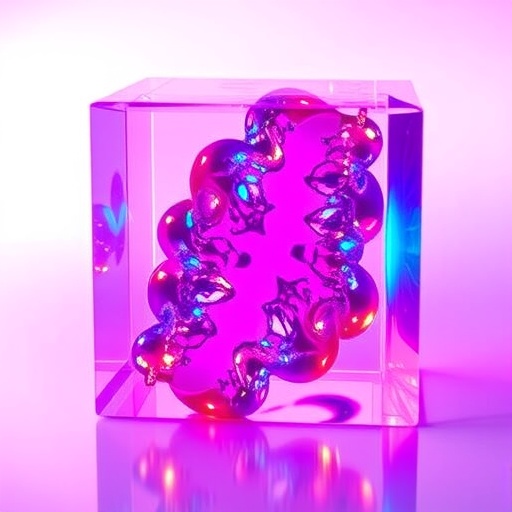A research team from the South China University of Technology has made significant strides in the field of optics by introducing a groundbreaking statistical modeling approach aimed at streamlining the development of advanced rare-earth-doped laser glasses. These glasses are pivotal in modern photonics and find extensive applications in areas such as telecommunications, solid-state lasers, and optical amplifiers, primarily due to their exceptional luminescent properties. The new approach, employing a model referred to as the neighboring glassy compounds (NGCs) model, allows for accurate predictions regarding the local structural environments and luminescence properties of intricate glass systems. This innovation is expected to drastically cut down the time-consuming experimental trial-and-error that has traditionally characterized the field.
Developing rare-earth (RE) doped glasses presents several inherent challenges. Their unique luminescent characteristics, which include high efficiency and broad emission spectra, are often counterbalanced by the complexity of the glass structures, leading to difficulties in understanding their medium-range order (MRO) and short-range order (SRO) structures. This complexity has hampered the rational design of laser glasses, which often relies on a trial-and-error methodology that is not only time-consuming but also limited in predictive capabilitites. The intrinsic amorphous topology of glass adds another layer of challenge, as scientists have grappled with understanding how structural intricacies impact optical behavior.
The crux of the research lies in addressing these limitations through the NGCs model, which recognizes that the surroundings of rare-earth ions within laser glasses can be treated as a statistical ensemble of configurations. This model provides a quantitative framework to articulate both the structural characteristics and luminescent behaviors of RE-doped glasses by focusing on average contributions from the neighboring glassy compounds. Such a distinctive outlook allows researchers to predict the structural characteristics and optical properties of various compositions across an expansive range, thereby optimizing the glass design process.
To validate the predictive accuracy of the NGCs model, the research team performed a detailed comparison of crucial local structural parameters such as the pair distribution function and the structure factor against results derived from molecular dynamics simulations. The model demonstrated a close alignment with experimental measurements, particularly for Er³⁺-doped quaternary germanate glass systems. This level of precision reassures scientists that the NGCs model can provide reliable insights into plant compositions and configurations that were previously uncharted.
One of the most significant aspects of this research is its emphasis on expanding the field of laser glass design. By effectively establishing a composition-structure relationship, the NGCs model empowers researchers to populate the composition-property space of complex glasses. This ensures a more targeted approach to discovering novel materials with desired luminescent properties and performance metrics. The model promotes a seamless transition from microscopic structural features to macroscopic optical behaviors, which is vital for real-world applications.
The multifaceted implications of this research are particularly noteworthy. As the model matures, it opens avenues for predicting not only luminescence properties but also other physical attributes such as thermal and mechanical properties of glass. These advancements can be instrumental in fine-tuning the material characteristics to meet specific demands in various industries, from consumer electronics to advanced scientific research.
Additionally, the capability of the NGCs model to produce multi-luminescence property charts is paramount for researchers. These charts serve as essential tools for identifying compositions that fulfill multiple constraints, thereby accelerating the pace of discovery in glass science. The application of high-throughput screening methodologies facilitated by the model may significantly reduce the time frame required for the design and optimization of new laser glasses.
Looking toward the future, the research team aims to further extend the applicability of the NGCs model. Potential areas of exploration include optimizing thermal management in laser systems and enhancing mechanical stability, thus providing a broader spectrum of application for these advanced materials. As scientists delve deeper into the complexities of rare-earth-doped glasses, the NGCs model may serve as a linchpin for innovation in materials science.
The significance of this research is underscored by its recent publication in the online journal Materials Futures, a notable platform dedicated to interdisciplinary materials science. The introduction of the NGCs model is timely and relevant, given the increasing global demand for advanced laser technologies.
In summary, the NGCs model represents a pivotal advancement in the understanding and design of rare-earth-doped laser glasses. By offering a predictive framework that bridges the gap between complex structural characteristics and optical properties, the model not only enhances the rational design process but also expedites the discovery of next-generation laser materials. With further validation and exploration, the methodologies established through this research have the potential to reshape the landscape of glass science and optical materials engineering for years to come.
Subject of Research: Development of rare-earth-doped laser glasses using neighboring glassy compounds model
Article Title: Rational design of chemically complex laser glasses via neighboring glassy compounds model
News Publication Date: 16-Sep-2025
Web References: 10.1088/2752-5724/adff9e
References: Zhenjie Lun, Minbo Wu, Di Zuo, Haojun Zou, Dongdan Chen, Shanhui Xu, and Zhongmin Yang.
Image Credits: Materials Futures*
Keywords
Rare-earth-doped glasses, Luminescence properties, Statistical modeling, NGCs model, Glass science, Optical materials, Photonics, High-throughput screening, Materials design.




